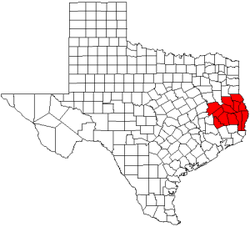Deep East Texas Council of Governments
 Logo | |
|
Map of Texas highlighting counties served by the Deep East Texas Council of Governments | |
| Formation | 1967 |
|---|---|
| Type | Voluntary association of governments |
Region served | 9,906 sq mi (25,660 km2) |
Membership | 12 counties |
| Historical population | ||
|---|---|---|
| Year | Pop. | ±% |
| 2000 | 355,862 | — |
| 2006 | 368,675 | +3.6% |
| Source: [1] | ||
The Deep East Texas Council of Government (DETCOG) is a voluntary association of cities, counties and special districts in Deep East Texas.
Based in Jasper, the Deep East Texas Council of Governments is a member of the Texas Association of Regional Councils.
Counties served
Largest cities in the region
| City | 2000 Population [2] |
|---|---|
| Lufkin | 32,709 |
| Nacogdoches | 29,914 |
| Jasper | 8,247 |
| Crockett | 7,141 |
| Center | 5,678 |
| Diboll | 5,470 |
| Livingston | 5,433
SECTION 8 HOUSING The Deep East Texas Council of Governments serves as a funding agency for the Section 8 Housing Assistance Program, or its new term “Housing Choice Voucher Program". Funding is provided through the U. S. Department of Housing and Urban Development. The Section 8 program provides rental assistance to low-income families in the private rental market through the Housing Assistance Payments program or Housing Choice Voucher Program. Rental voucher holders select a unit from the private rental market. Rental assistance makes market rate housing affordable. Program participants normally pay no more than 30% of monthly adjusted income towards rent and utilities. The Housing Assistance Payment subsidizes the balance of the rent to the property owners. |
DETCOG 9-1-1
DETCOG 9-1-1 works with agencies throughout the 12 county region by providing planning and technical assistance to ensure delivery of 9-1-1 calls to the proper Public Safety Answering Point (PSAP). In a cooperative effort, DETCOG 9-1-1 works with local Telephone Companies, Wireless Telephone companies, Voice over Internet Providers (VoIP), County 9-1-1 ALI Coordinators, and others in the region to ensure that each 9-1-1 call reaches the correct PSAP with the right location and telephone information. In addition to planning and technical assistance, DETCOG 9-1-1 offers a variety of training to every PSAP employee. Training on the use of the 9-1-1 equipment in place at the PSAP and Telecommunications Device for the Deaf (TDD) . Any successful 9-1-1 program depends on public awareness. To that end, DETCOG 9-1-1 provides items to PSAPs and other public safety agencies designed and developed to enhance the understanding of the 9-1-1 program throughout Deep East Texas. These materials cover a broad range of topics associated with the proper usage of 9-1-1, wireless 9-1-1, and VoIP. They are available in English and Spanish. The Commission on State Emergency Communications (CSEC) is the state agency that oversees the 9-1-1 Program. They provide guidance and direction for all twenty-four Council of Governments (COGs) with regard to expending 9-1-1 funds, training, and accountability. The 9-1-1 Program is funded from the $.50 fee on each telephone line reflected on an individual’s telephone bill (i.e. wireline, wireless and VoIP). Telephone Companies then remit those funds to the Texas Comptroller who sends CSEC the amount appropriated by the Texas Legislature. CSEC, in turn, allocates to each of the COGs their share based on the population of that Region.
References
- ↑ Total Population Estimates for Texas Councils of Governments - Texas State Data Center.
- ↑ "American FactFinder". United States Census Bureau. Retrieved 2008-01-31.
External links
- Deep East Texas Council of Governments - Official site.
| ||||||||||||||||||||||
